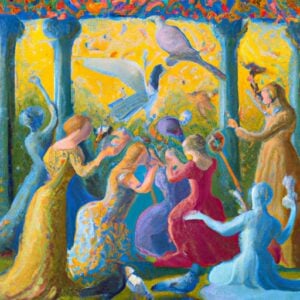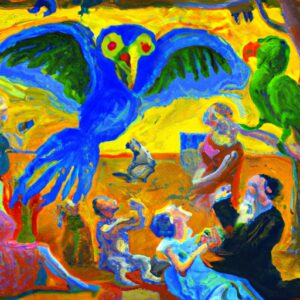Italian grammar genders: masculine and feminine
Nouns are the words used for people, animals, things, and places.
In Italian grammar, all nouns are classified according to their grammatical gender, and there are only 2 grammatical genders: masculine and feminine (maschile e femminile).
There is no neutral gender. In addition, most masculine and feminine nouns can be singular or plural.
The gender of Italian nouns can often be established by looking at the word ending, but there are many exceptions.
The general rule is that nouns ending in “-o” are masculine, and nouns ending in “-a” are feminine.
Nouns ending in “-e” can be either masculine or feminine. The only way to know the gender of the noun is to look them up in a dictionary or look at other elements of the sentence, for example, articles and adjectives.
Masculine and feminine nouns: rules
Nouns ending with “-o”:
- Most nouns ending with “-o” are masculine
- The plural form of masculine nouns ending with “-o” is “-i”
Example: libro (=book)
| Masculine | |
| Singular | libro |
| Plural | libri |
Exceptions: some very common nouns ending with “-o” are feminine! For example, la mano (= the hand), l’auto (=the car), and la moto (the motorbike).
Nouns ending with “-a”:
- Most nouns ending with “-a” are feminine
- The plural form of masculine nouns ending with “-a” is “-e”
Example: tazza (=mug)
| Feminine | |
| Singular | tazza |
| Plural | tazze |
Exceptions: some very common nouns ending with “-a” are masculine! For example, il papà (= the dad), l’aroma (=the odor), il parabrezza (the windshield).
Nouns ending with “-e”:
- They can be either masculine or feminine
- To know the gender of these nouns, you can use the dictionary or check other elements of the sentence (like articles or adjectives)
- The plural form of ALL nouns ending with “-e” is “-i”
Example: fiore (=flower), masculine:
| Masculine | |
| Singular | Fiore |
| Plural | Fiori |
Example: television (=television), feminine:
| Feminine | |
| Singular | televisione |
| Plural | televisioni |
Nouns that have both masculine and feminine forms:
- Many nouns that refer to people (or even pets) can be both masculine or feminine, according to the actual gender of the person they refer to
- They change the ending vowel according to their gender
Example: gatto/gatta (=cat)
| Masculine | Feminine | |
| Singular | gatto | gatta |
| Plural | gatti | gatte |
Example: cameriere/cameriera (=waiter/waitress)
| Masculine | Feminine | |
| Singular | cameriere | cameriera |
| Plural | camerieri | cameriere |
Masculine and feminine nouns: How to use them with adjectives
In Italian, adjectives are usually placed after the noun they refer to. Adjectives can end in “-o”, “-a”, or “-e”.
Adjectives ending with “-o”:
- They are used with masculine nouns
- The plural form of adjectives ending with “-o” is “-i”
Adjectives ending with “-a”:
- They are used with feminine nouns
- The plural form of adjectives ending with “-a” is “-e”
Example: carino (=cute) with gatto/gatta (=cat, masculine and feminine)
| Masculine | Feminine | |
| Singular | gatto carino | gatta carina |
| Plural | gatti carini | gatte carine |
Adjectives ending with “-e”:
- They are used with both masculine and feminine nouns
- The plural form of adjectives ending with “-e” is “-i”
Example: interessante (=interesting) with libro (=book, masculine) and tazza (=mug, feminine)
| Masculine | Feminine | |
| Singular | libro interessante | tazza interessante |
| Plural | libri interessanti | tazze interessanti |
Practice with Quizlet
Here's a set of flashcards and quizzes to practice this grammar topic.Gender of nouns and adjectives: what to remember
Nouns, which are words used for people, animals, things, and places, are classified according to their grammatical gender.
In Italian, there are only two grammatical genders: masculine and feminine (maschile e femminile).
Unfortunately, there is no neutral gender.
Most masculine and feminine nouns can be singular or plural.
To determine the gender of a noun, look at the word ending.
Generally, nouns ending in “-o” are masculine, and nouns ending in “-a” are feminine. However, there are some exceptions.
Nouns ending in “-e” can be either masculine or feminine, and the only way to know its gender is to look it up in a dictionary or look at other elements of the sentence, such as articles and adjectives.
When it comes to adjectives, they usually follow the noun they refer to.
Adjectives ending in “-o” are used with masculine nouns, “-a” are used with feminine nouns, and “-e” with both masculine and feminine nouns.
The plural form of adjectives ending in “-o” and “-e” is “-i”, and the plural form of adjectives ending in “-a” is “-e”.
Some nouns that refer to people, or even pets, can be either masculine or feminine, depending on the gender of the person they refer to. In this case, the ending vowel changes according to gender.
We hope this information helps you understand the Italian grammar genders better!










10 Responses
Grazie Stefano. Il corso e perfetto. (Sorry I don’t have an italian keyboard)
Ciao Mark!
Siamo molto contenti che il corso ti stia piacendo 🙂
Non ti preoccupare se non hai abilitato la tastiera in italiano.
I’m confused: Is this correct: “Nouns ending with “-a”:
Most nouns ending with “-a” are feminine
The plural form of masculine nouns ending with “-a” is “-e” ”
I thought it was il problema > i problemi
il problema è maschile. è un eccezione.
just a reminder…John’s comment above still appropriate a year later.
No, I fixed it when I said that I fixed it.
Prego. Sono molto contento di aver trovato il tuo meraviglioso corso di italiano. Grazie.
Sei molto carino! 🙂
It looks to me that a typo exist above under:
Masculine and feminine nouns: rules
The text states: “most nouns ending in o are masculine”.
In the next section I see: “most nouns ending in o are feminine”.
Please clarify for me. Grazie.
E’ vero, l’ho corretto. Grazie!